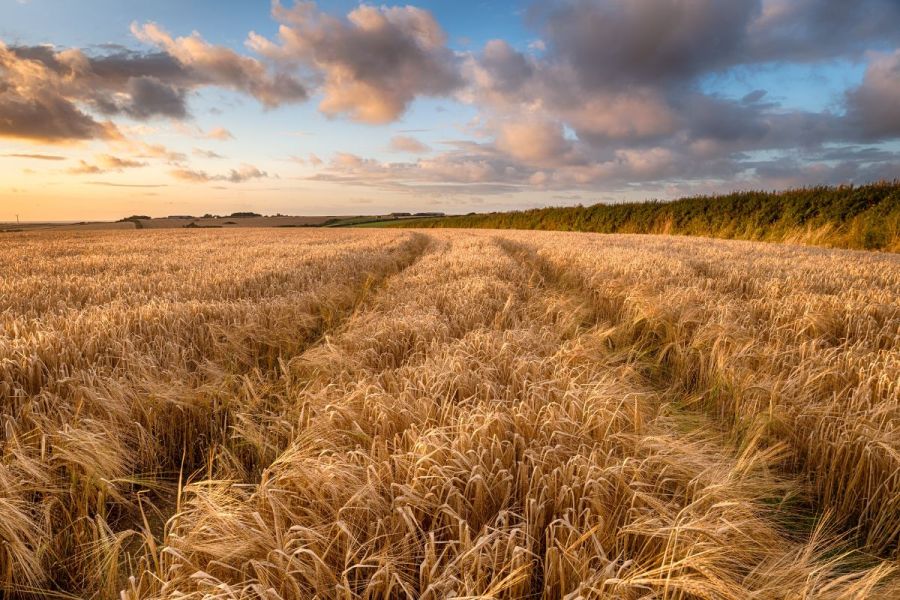Stress is arguably the single biggest risk factor for any barley crop. CPM attended a BASF roundtable to discover why preventing stress in the crop is important and how this can be done while facing numerous challenges.
“Treat barley like it’s a piece of cotton wool.”
By Melanie Jenkins
One common denominator could be claimed to link growing a successful barley crop, be it winter or spring, for feed, malting or distilling, and that is removing stress. And reducing it from the outset is key, says Andrew Smooker of BASF.

Barley programmes should be tailored over the course of the season according to the variety being grown and whether it’s a hybrid or two-row conventional, says David Leahy.
And there’s not one single way of doing this. Instead, it requires a combined approach of selecting the right variety, optimising crop nutrition, using the correct crop protection and actives, as well as making sure PGR choice and the timings of all of the above are as precise as possible, adds BASF’s David Leahy, suggesting it’s best to “treat barley like it’s a piece of cotton wool.”
The majority of growers are aiming to maximise their yields, and variety choice is really important for this, he says. “However, this is often dictated by the market. In some cases it’ll be the feed market, but in others it’ll be down to grassweed pressure. And barley programmes should also be tailored over the course of the season according to the variety you’re growing and whether it’s a hybrid or two-row conventional, as these require two very different approaches.”
Getting things right with barley starts at the very beginning, says David. “It’ll be down to establishment technique and keeping seed rates high as barley responds well to this. You can’t put barley into poor conditions as it has to hit the ground running. Be it in autumn or spring – the crop has to be able to build density and biomass.”
He suggests that aiming for 1000 shoots/m² should be the bare minimum. “I think mistakes can often start on day one if not enough seed is put into the ground.”
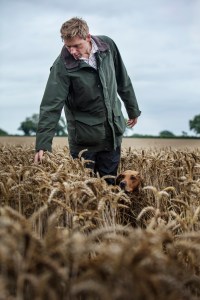
Toby Hogsbjerg believes BYDV resistant varieties are the way forward in tackling the disease.
Toby Hogsbjerg, farm manager at The Wicken Farms Co in Norfolk is growing both winter and spring barley. “We’re bringing more winter barley in to give us a double break between root crops. And although we used to grow a lot of hybrids, we’ve moved back to conventional varieties purely for establishment reasons. The population density is a lot higher which helps us to combat other issues and is better for the soil.”
Three fifths of Peter Chapman’s rotation is down to barley on South Redbog Farm in Aberdeenshire. “We only grow hybrid winter barley, operating a high input, high output system and everything goes for feed. Winter barley is used as an early entry to oilseed rape, whereas spring barley is grown based on what suits agronomically.”
In Wales, Julian Radcliffe of Penmark Farm grows two-row winter barley to feed his beef cattle, with surplus sent to a feed mill. “Barley fits into our system to spread the workload and acts as a buffer if we run short of forage, plus the straw is valuable in this area.”
According to independent agronomist, Joe Conroy, farmers in the north east of the Republic of Ireland (ROI) are still getting results from barleys that have been left behind in the UK. “Some are growing barley for feed and others for seed, with the most common six-row being Belfry, while KWS Tardis is the newest two-row we’re seeing.”
Nutrition is a very important aspect of a successful crop, says David. “Nitrogen, phosphorous (P) and potassium (K) – especially K – are so important. And barley really is an N hungry crop, particularly when you consider the slots it’s grown in a rotation. Winter barley, and spring barley, are often grown as second and third cereals.”
Something else David has observed in his time as an agronomist is how well barley responds to potash. “There’s a strong correlation between good N uptake and the right level of potash, which can be seen as a yield response.”
One thing Toby finds difficult is getting N right on his light Norfolk soils. “I’m still learning my way with this. Cereal crops get an application of N, P and K but really the root crops on farm feed the cereals.”
Peter is unable to grow spring malting barley on his land, despite the area being dominated by it, because his soils are too fertile. “We can’t produce low N crops because our nutrition has been based around organic manures for the past 40 years. Aberdeenshire soils are inherently infertile and acidic but ours have organic matter levels between 7% and 9%.
“We have 50 suckler cows which produce farmyard manure that has all the P and K we require, but we do usually apply a small amount of phosphate to our spring barley and use potash on winter crops,” he explains. “Putting fertiliser down the spout with the seed is vital to our spring barley establishment as it helps get it up and going. The crop requires momentum and this provides it.”
To get his crop away and aid root development, Julian puts 250kgN/ha on in the spring as soon as he can. “Potash and phosphates have been applied variable for the past 20 years, and we use muck from the cattle.”
Joe advises that those using inorganic manures should apply them early. “Barley is a crop that if it stops growing for one minute, it loses yield. It has to keep going from beginning to end, so plan your fertiliser programme in relation to this.”
Where there are trace element deficiencies, a crop is going to be stressed, flags David. “Don’t neglect sulphur and trace elements such as manganese, zinc and magnesium.”
Toby uses a lot of manganese, which is an issue in his soils. “We use a huge amount of it to keep our plants green and growing.”
Manganese was an issue for Peter for a while, so he applies a manganese sulphate at the start of each season. “We also have an issue with copper, so we apply it in foliar form at the same time and then use magnesium to aid grain fill at the tail end of the season. We also use biostimulants on spring barley to try and prime it to fight ramularia,” he adds.
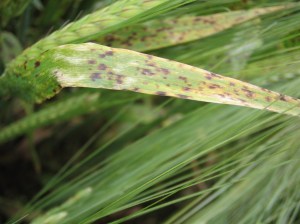
Although ramularia may be the focus at T2, experts agree that taking a programme-wide approach is the best way to manage it.
But equally, David highlights that pH and lime shouldn’t be forgotten. “These are both really important and barley responds well to good pH levels, requiring a minimum pH of 6.2.”
It’s also important to choose the correct PGR, he advises. “Select PGRs for their purpose, be it to suppress apical dominance to even crops out, or to manage root or stem lodging. However, be really conscious about the application of late PGRs as these can put crops under severe stress.”
Peter feels a lot of growers don’t appreciate the important role that PGRs play in agronomy. “We’re always getting drier summers, and crops have to be rooted well to cope. We use Modus (trinexapac-ethyl) and chlormequat if we feel the crop could fall over, plus brackling can be an issue with hybrids. Spring barley receives an application of Medax Max (prohexadione+ trinexapac-ethyl) at GS31/32 which we’ve found to be excellent.”
Taking a different approach, Julian applies chlormequat at GS30 and Canopy (mepiquat chloride+ prohexadione-calcium) at GS37. “I’m a big fan of Canopy from a stress perspective as I don’t think it’s too harsh on the crop.”
In terms of crop protection and its timing, early disease control at the T0/T1 timing is vitally important, says David. “These timings are so valuable, purely down to the fact we’re trying to retain tillers at this point. We want to maintain them throughout the season because yield correlates with the number of ears in barley.”
In the ROI, where some diseases can thrive under the damper conditions than in the UK, Joe believes in implementing a robust fungicide programme before disease can get a foothold. “We have a three-spray programme, and our last spray is later than many people recommend, waiting until the ear is almost fully emerged. You can’t substitute a three-spray programme in our climate. You have to prevent disease, or you’ll end up fighting rhynchosporium, net blotch and mildew until the end of the season.
“And planning is important because you only have a certain number of spray days and you have to use them as and when you can. If you miss out by three, four or five days, rhynchosporium can run rampant,” he says.
Peter also likes to take a three-spray approach to fungicides. “We always use them preventatively and, in my mind, aim to apply three sprays on winter barley, though the past two years have been so dry that we’ve only had to apply two.”
But managing stress in barley also means not overloading spray tanks as this can put too much pressure on a crop, highlights David.
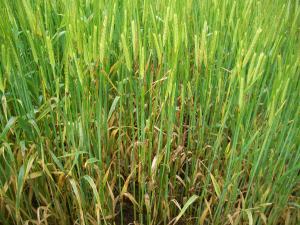
Prothioconazole remains the primary azole available for rhynchosporium control.
Prothioconazole is still the primary azole available in terms of rhynchosporium control, he explains. “But it can’t and shouldn’t be used alone. We’re very fortunate to have it but it should be partnered with other actives to take the selection pressure off.”
David suggests it’s helpful to consider fungicides by the actives they contain rather than product names. “For example, Revysol (mefentrifluconazole) is the most active azole solution for ramularia, but pyraclostrobin is a useful active to manage net blotch, especially the difficult strains we now have to deal with. It also has activity against brown rust.”
The UK is dealing with a specific mutation of net blotch at present, F129L, which is negatively affecting strobilurins, explains David, who reiterates the importance of using a mix of actives from different groups of chemistry. “We know there’s resistance to SHDIs and so now we’re using a combination of products in tank mixes, which should include the most robust strobilurins, like pyraclostrobin, which are less affected by F129L.”
But SDHIs, such as fluxapyroxad, still have a major role to play in barley disease programmes, adds David. “This is absolutely critical in terms of brackling and fluxaproxad is a key active to control rhynchosporium. So it’s just about making the best use of the actives at our disposal.

According to Joe Conroy, barley is a crop that has to keep going from beginning to end, so fertiliser programmes should be planned accordingly.
“In terms of T2, there’s a definitive link between green leaf area and yield, which comes out in trials every year. In barley, this timing is all about prolonging green leaf and managing ramularia,” he adds.
Andrews flags that keeping the crop greener for longer can have a big impact. “Those extra few days of greenness in a crop at the end will be reflected in yield. So it’s not just about disease control but also about healthy canopy duration alongside it.”
Although ramularia may be the focus at T2, taking a programme-wide approach is the best way to manage it, says David.
According to Scott Milne of BASF, while both net blotch and rhynchosporium can be well controlled with the actives available, with ramularia the approach is different as the disease is triggered by the crop coming under stress, often during anthesis. It’s now a case of delaying the onset of ramularia by preventing crop stress.”
David also warns growers to be conscious of barley yellow dwarf virus (BYDV) and take-all, particularly as they put the crop under stress. “Crops which had large infections of these diseases last year in the southern part of the ROI were decimated by ramularia, demonstrating the impact stress can have on a barley crop.”
BYDV is one of the issues Toby has been struggling with. “Sadly, we’ve a big problem with aphids in this area but hopefully the issue of BYDV is starting to get more traction. We’ve been growing Sensation, which is BYDV resistant, but unfortunately its specific weight hasn’t been stacking up. But I do think using BYDV resistant varieties is the way forward.”
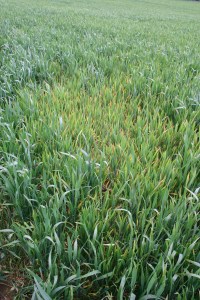
BYDV had a severe impact on a lot of winter barley crops in the Republic of Ireland last year.
According to David, BYDV had a severe impact on a lot of winter barley crops in the ROI last year. “We had crops that barely made over 3.7t/ha because BYDV and take-all had decimated them.”
Julian sprays once for aphids in the autumn as routine. “We conducted trials which showed that BYDV could be devasting in the wrong year, but we’ve never had a total failure so we seem to be managing it.”
David sums up proceedings by reiterating the importance of taking a holistic approach to the barley crop, paying close attention to crop nutrition as well as disease control to help keep the crop under minimal stress.
“For early fungicide application, which is the most important fungicide timing in barley, the combination of the three leading actives in Tevos (fluxapyroxad+ pyraclostrobin) plus Innox (prothioconazole), can cover bases without making prothioconazole carry all the weight. Pyraclostrobin provides activity on net blotch, while fluxapyroxad covers rhynchosporium, with prothioconazole as the key early timing azole.”
And where there’s a risk of ramularia, growers can utilise Revystar XE (fluxapyroxad+ mefentrifluconazole) to cover all the bases, he concludes.
This article was taken from the latest issue of CPM. For more articles like this, subscribe here.
Sign up for Crop Production Magazine’s FREE e-newsletter here.

